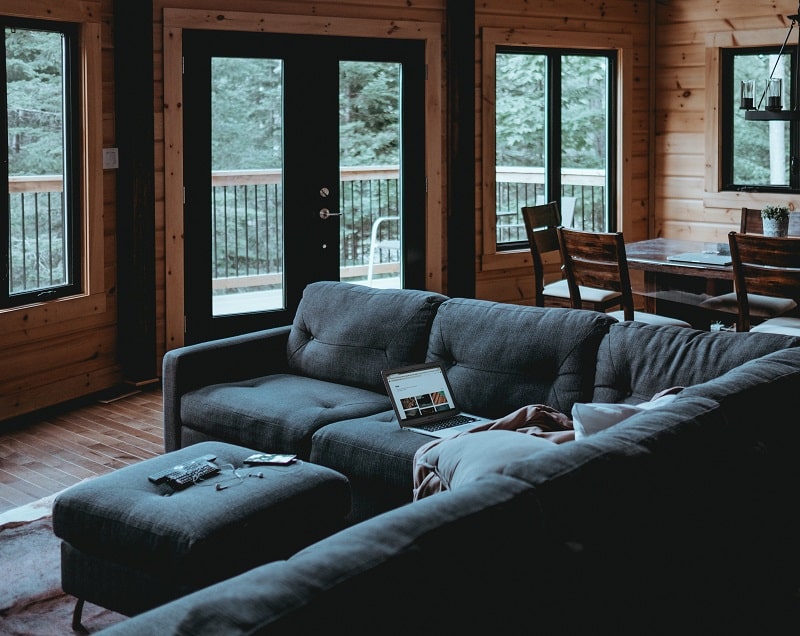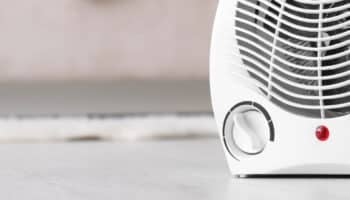You’re warm, you’re cosy.. and you’re anxious.
That electric heater is doing a great job, but how much is your bill going to be?
Is it powered by electricity, or pure money-guzzling power?
I’ve always wondered exactly how much an electric heater costs to run. So I did the research, and even made a free calculator.
On average, a 1,500W heater costs around $0.20 per hour to run on high. This adds up to a cost of $1.60 for 8 hours a day, and $48 per month. The running costs depend on your electric heater’s power, running time, heat settings, and your electricity price.
If you want to know how much your electric heater probably costs to run, try this free calculator I’ve made below. Just follow the inputs to get your own personal estimates.
Costs per hour may be low, but the monthly price adds up quickly!
How the Cost to Run an Electric Heater is Calculated
For any curious readers out there, let’s dive into explaining the calculator.
Determine your Wattage
As you can see in the calculation example above, the first part of the equation you need is the unit’s power usage. Some heaters are rated by watts, meaning an extra calculation isn’t necessary. But some heaters are rated by their heat output or BTUs (British Thermal Units).
To convert BTUs into watts, use this calculation:
- 1 BTU = 0.293 Watts
So if you have a 5,000 BTU space heater, that would be equivalent to 1,465 watts.
Heat Settings
You’re probably not running your portable heater on high all the time. Since that may not be the case, here are the estimates on wattage usage.
- High setting: 100% of the rated wattage
- Medium setting: 70% of the rated wattage
- Low setting: 40% of the rated wattage
Since our settings often vary, I recommend using the worst case to give a more conservative estimates.
As an example, if you ran a 1,500-watt heater at the medium setting, the wattage you would use would be:
- 1,500 x 70% = 1,050 watts
Hours per Day
With the hourly rate figured out, we need to figure out a cost per day.
You’re probably not using the heater all day and night – so try and estimate how long it’s on for, per day.
A Note on Kilowatts
The power usage of your heater is rated in watts, but your electrical company bills you by kilowatts—which is a measurement of the amount of energy you use when you run a 1,000-watt appliance running for an hour.
As an example, if you leave a lamp or light on that has a single 100-watt bulb for 10 hours, you will use one kWh of electricity. And a 2,000-watt appliance turned on for half an hour would use 1 kWh or electricity.
Let’s say you live in Alaska. We’ll use the pricing from the chart below and round it up.
- 1,500-watt heater x 16 hours a day = 24,000
- 24,000 / 1,000 = 24
- 24 x .23 KWh = $5.52
So if you live in Alaska and only turn your portable electric heater off when you go to bed, you’re paying $5.52 per day. But make sure the price you use is after all the fees and charges on top of your cost for the electricity itself.
I’ll get into that in the next section.
Determine your cost per kilowatt hour (kWh)
Next, you need to know the amount you’re being charged for your electricity, and that will vary by locale. Click here to find out the cost of electricity in your state.
If you’re like me, your local electric company also has an assortment of extra charges and fees on top of that, like the cost to deliver the electricity to your home. So you don’t have any surprises, it might be a good idea to factor those into your KWh price.
Here is an example of the extra fees and charges you might have on your bill but note that these can differ by locale.
- Fixed charges. This is an amount you have to pay before your meter even starts running and could be at least $10 per month
- Regulatory charges
- New infrastructure
Another thing to be aware of is the type of plan you have. Are you on a fixed rate plan or a variable rate plan?
Texans on variable rate plans who suffered through bad snowstorms and cold weather in early 2021, were in for an expensive surprise. For those that did have power, it was costing them a fortune. Some received electric bills up to $17,000 because in a perfect storm situation—excuse the pun—demand was outstripping demand, regulators raised energy prices, and the wholesale price for electricity jumped more than 10,000 percent.
That was a bit of a tangent, but you get the idea. The kWh price on your bill could actually translate into something much more than that.
As the last step, once you’ve calculated your costs per day, you can obviously multiply that out to your costs per week or month.
And that’s it! You are now a pro at figuring out how much it costs to run your electric heater. Or any appliance, for that matter.
Now, how about I spend some time going over the most efficient types of electric heaters? If you’re still in the research and decision-making stage, it might be helpful for you.
Efficient Portable Electric Heaters: What are Your Options?

Unless you have money to burn, efficiency matters.
There are several types of heaters that are cheaper to run. According to some info we’ve already curated on this site, these are the cheapest electric heaters:
- Infrared heaters
- Oil-filled heaters
- Storage heaters
- Ceramic heaters
- Space heaters
Infrared heaters. They heat a room faster than other types and also use less energy to operate. Overall, this makes them the cheapest to run.
Oil-filled heaters. These heaters are over 99% efficient due to the fact nearly all the electricity they use is converted into heat.
Storage heaters. As the name suggests, these heaters store energy. The benefit here is they obtain the electricity during off-peak hours, which saves you money.
Ceramic heaters. You can find them anywhere and they are a low-cost option in terms of upfront costs, but lower energy efficient when calculating long-term costs.
Space heaters. These offer the same benefit as ceramic heaters, but they’re a less energy efficient.
Do Electric Heaters Use A Lot of Electricity?
There’s no definitive answer here, as there are many types of electric heaters as well as models with varying wattage.
In general, electric heaters use about 1,500 watts when you run them on high. That’s about 12.5 amps. Have you ever plugged in a portable heater and had it trip a circuit breaker?
Most homes in North America have 15-amp circuits—plus a few 20 amp—so depending on what else is on that circuit, like a toaster or hairdryer, you are going to have problems. So yes, comparatively speaking, electric heaters use a lot of electricity. Using it for 1 hour will cost you 15 times the amount it will cost you to leave a light on with a 100-watt bulb for an hour.
Here are some amp draws for several other appliances you may use around the home. On a 15-amp breaker, you could not run any of these and your heater at the same time. Note that this is assuming the appliances are on high.
- Blender: 6 amps
- Coffee Maker: 8 amps
- Electric Kettle: 12 amps
- Food Processor: 8 amps
- Iron: 12.5 amps
- Microwave: 15 amps
- Toaster: 9 amps
- Vacuum cleaner: 9 amps
You could not run any of these at the same time and on the same 15 amp circuit.
So if you’re planning on buying a heater, find out what circuits you plan to run them on, and what you’re already using on that circuit.
How Can I Heat My Room Cheaply?

Now that you know the possible costs of running a portable electric heater, what are some things you can do to mitigate the cost?
Yes! Here’s a few suggestions.
Insulated or Blackout Curtains
Unless you have very expensive double or triple paned windows with gas between the panes, you are likely looking at heat loss through them.
Blackout or insulated curtains are made from materials with a very heavy weave. They also have an insulated backing that looks something like rubber. The beauty of these is that they will help to keep your rooms warmer in winter, but cooler in summer as well.
They are also very reasonably priced, you can find them in all sizes, and they are available in tons of colors.
Use Weather Stripping or Door Draft Stoppers
If your chilly room has an exterior door, you may need to apply some weather stripping around it. This will seal the weather out. And while you’re at it, and before you hang your new curtains, see if your windows could use some weather stripping as well.
If you have an interior room that’s still catching drafts along the floor, consider getting something called a Door Draft Stopper.
Interior doors typically have quite a bit of space between the bottom of the door and the floor, so something to keep chilly breezes on the other side of it might be your answer.
Put Down Rugs or Carpet
Gleaming hardwood floors are a thing of beauty, but they aren’t terribly energy efficient. And just like we add layers of clothes to shield us from the cold, adding a layer of carpet or rug will do the same for a room.
These simple steps will work wonders at making your heater more efficient. Which means they are a great way to heat your room cheaper.
Is It Cheaper to Leave Heating on Low?
If all things are equal, then yes.
What do I mean by that? Well, since you are leaving the heater on low, do you need to run it longer because it’s taking forever to heat up your room? Or would you run it for the same amount of time you would run it if you had the heat blasting?
Because .5 x 2 = 1. And 1 x 1 = 1 as well. Meaning if you run your heater for a while at a low power, it’s going to cost much the same as it would to run it on high for half the time.
What you could do is take advantage of the tips mentioned above on how to run your heater cheaply. Put those tips in place and run your heater on low, and yes, it will be cheaper.
Conclusion
By now you should be feeling quite educated—I hope—on calculating how much it costs to run an electric heater. Whether you use our calculator and do the math longhand. And really, why would anyone do that?
Both the US and Canada have some variations in the cost of electricity per kWh. Knowing how much you pay locally can help you determine what kind of heaters to buy in the first place and then how much you can run them while staying within any budget you might have.
If you enjoyed this guide, we also have calculators on:







